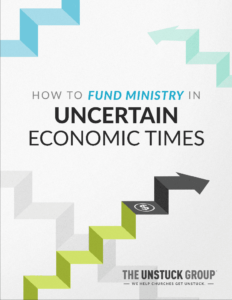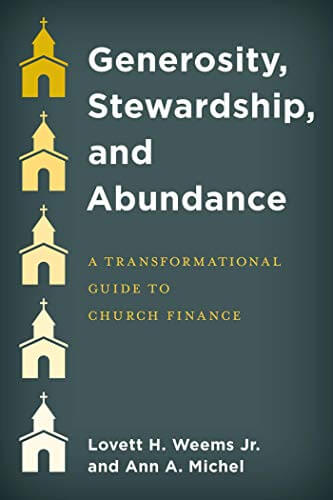In working with more than 500 churches, The Unstuck Group identified certain expenditure areas where churches commonly invest too little and those where churches tend to invest too much. Their findings may offer clues to bringing a better balance to your church’s budget.
Many churches underinvest in some aspects of their ministry while other aspects of their ministry have disproportionately large budgets. The areas of underinvestment are often missing links between their budget and their vision. Other, more inflated areas provide hidden dollars if you look closely enough. Here are some things to consider when attempting to bring a better balance to your church’s budget.
Where churches often invest too little
1. Salaries and benefits
While no one should expect to get rich leading in ministry, it is important to ensure staff members are compensated well for their gifts and experience. Consult church salary reports provided by churchsalary.com and other organizations. Also consider the cost-of-living and average salaries in your community. In addition to salary, take a fresh look at your benefits package, including insurance and retirement contributions. Ultimately, it’s important to provide well for your staff and their families so they can stay focused on leading the ministry. The Unstuck Group encourages churches to hire fewer, high-capacity staff leaders with above average compensation, rather than hiring many staff members and struggling to compensate them appropriately.
2. Leadership development
Support the growth of your staff members by making development opportunities accessible to them. Budget for their attendance at conferences, coaching networks, online trainings, etc. Don’t confuse seminary tuition stipends with leadership development. While it is great to invest in seminary education, practical leadership development is equally important. We recommend allocating 3% of your operating budget to leadership development and strategic planning resources.
3. 10% margin
Many churches simply lack margin in their budget. Then contributions slow down or unexpected costs arise, their ministries are forced to cut back or pause. This can be avoided with built-in margin. We recommend that a church budget on 90% of its previous year’s contributions. Any additional contributions can then be saved for capital improvements or vision initiatives, such as new campuses, building expansions, etc.
Where churches often spend too much
1. Overstaffing
The Unstuck Group encourages churches to keep their total staffing expenses at 45-55% of the annual budget. To do this, we encourage churches to aim for a staffing ratio of 1 full-time equivalent for every 75-100 average attendees. That ratio includes all paid individuals, not just pastors and ministry staff. When you staff far beyond that, either the ministry budget is sacrificed or staff members are underpaid. It is far better to staff fewer and pay more than to staff more and be forced to pay less.
2. International missions
We are all for investing in international missions! However, we have seen churches that cannot accomplish effective ministry locally because they are giving so much internationally. The typical reason is that the church’s vision for its community pales in comparison to the vision cast for missions efforts. Understandably, people give to the greater vision. The truth is that everything you do is (or should be) missions-minded, focused on leading people to Christ. Your church should be as generous as possible toward international missions without compromising its local mission and vision. Otherwise, the church’s future is in jeopardy and its missions giving will not be sustained.
3. Ineffective ministries
Rebalancing the budget can be a great opportunity to eliminate a sacred cow or cut a ministry that competes with your reach and discipleship strategies. All ministry is good, but not all ministry is effective. Every ministry should predetermine what success looks like over the course of a year. If those goals are not hit, it may be time to prune that ministry strategy and try a new “How.” Ironically, these are often the cuts that leaders try to avoid. They often come with hard conversations about ministries with deep histories. The truth is, if these ministries do not have a place in the future vision for your church, the conversations should have probably happened before now. Now that you have a strategic plan requiring greater investment, you can no longer afford to allow ineffective ministries to continue. The good news is that it is easier to make these cuts when you can help people see how you are shifting financial resources to expand the mission and vision.
4. Inefficient practices
This is an opportunity to “trim the fat.” Look around the organization and identify areas of inefficiency. They are likely to be found between ministry silos where duplicate spending often takes place. Ask yourself, what resources could the team be sharing instead of purchasing separately? What systems do you lack that result in increased project costs? How can you adjust midweek building usage to reduce utilities? Are there any unnecessary expenses you could cut and never miss? Pull ministry leaders together to identify and reduce these inefficient practices.
5. Inflated ministry budgets
It is common knowledge that many ministry leaders pad their operating budgets to leave room for unexpected expenses. Rather than inflating the budget in every ministry area, create a single contingency account that any ministry can request funds from when necessary. This will ensure your budget is based on what you actually plan to spend and that contingency funds are only used when unexpected needs truly arise.
Talk About It! Where are the “missing links” in your own church budget? How about the “hidden dollars” you may be able to repurpose? By identifying “hidden dollars” and reinvesting them in “missing links,” you’ll be positioned for the future with a budget that prioritizes what matters most. Ultimately, you’ll be funding the vision … and nothing else.
 Excerpted from How to Fund Ministry in Uncertain Economic Times, The Unstuck Group, 2022. Used by permission. Download the free guide.
Excerpted from How to Fund Ministry in Uncertain Economic Times, The Unstuck Group, 2022. Used by permission. Download the free guide.
Related Resources
- Developing Your Operating Budget, a Lewis Center video tool kit resource
- Is Your Church Spending Too Much or Too Little on Personnel? by Lovett H. Weems Jr.
- Working Through the Stages of Grief when Cutting Your Budget by Dan Pezet
If you would like to share this article in your newsletter or other publication, please review our reprint guidelines.







